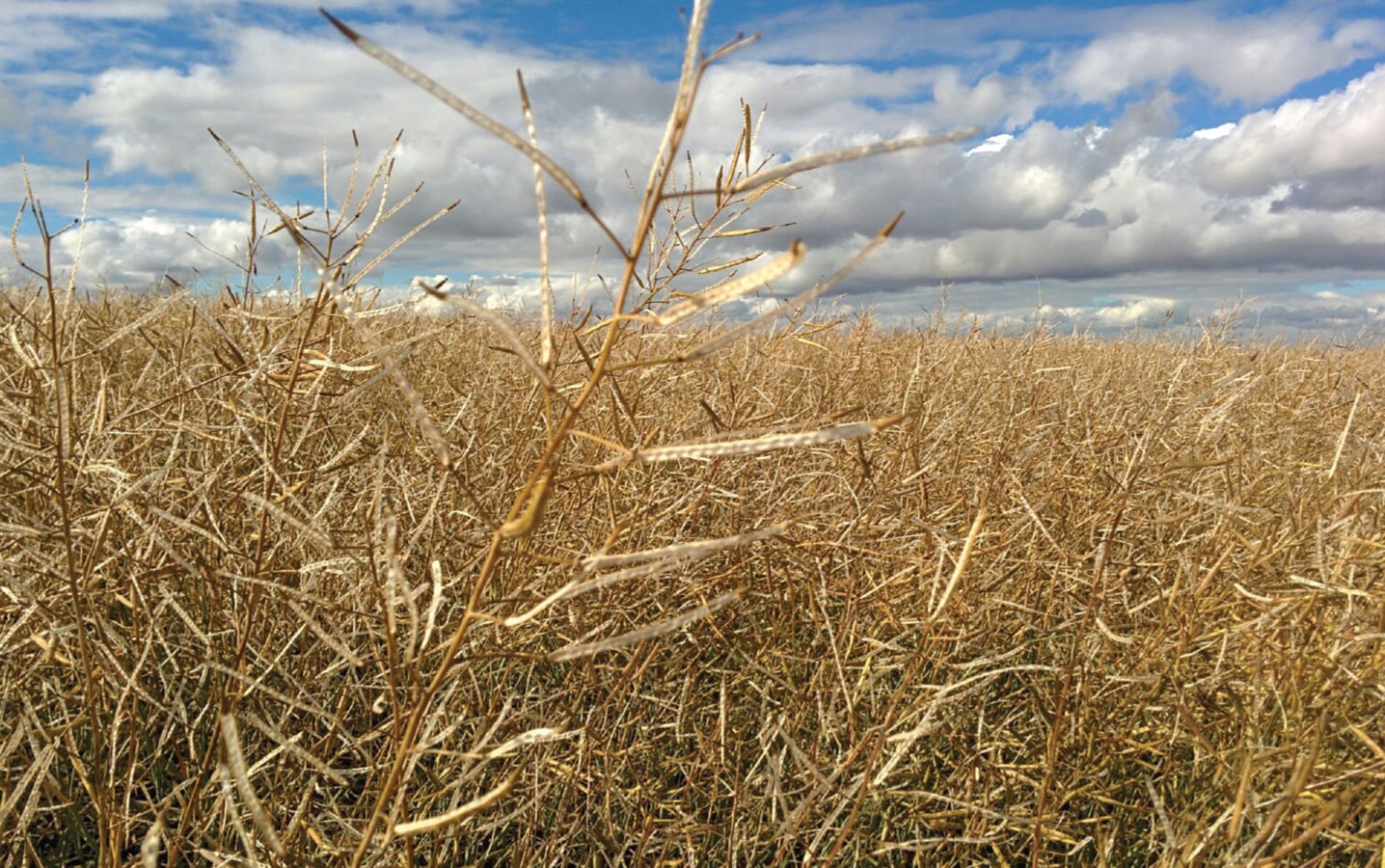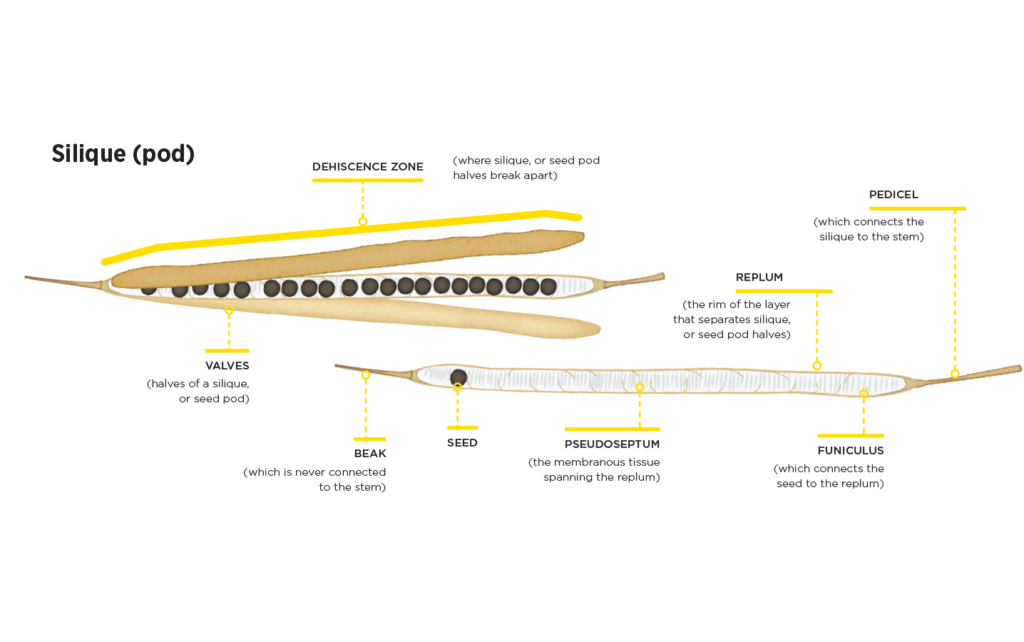Not All Pod Shatter Resistance is the Same
Growers need to know two important things about pod shatter resistance. First, hybrids with pod shatter resistance do not all have the same level of resistance. Second, pod shatter resistance does not reduce or prevent pod drop, which is another risk when canola is left standing for straight combining. The bottom line is that pod shatter resistance will reduce the risk of yield loss when straight combining, but it doesn’t completely eliminate risk to pod drop and loss.
The Canola Council of Canada, in collaboration with seed companies, is working on a pod shatter rating scale to describe the differences in pod shatter resistance among commercially-available hybrids. This will be similar to a lodging score already widely adopted by industry. The hope is to have this ready some time in 2022. In the meantime, this article will describe a few tips to make sure canola is straight combined before pod shatter begins.
Harvest timing considerations
The high potential for yield loss before and during canola harvest is due in part to the non-synchronous nature of pod and seed maturation – bottom pods mature faster than top pods and the main stem matures at different rate than side branches. If the plant matured uniformly, it would be much easier to manage.
Shattered pods drop their valves and seeds, leaving nothing but the membranous pseudoseptum attached to the plant.
Growers often use one of three strategies to time the start of straight combining. It can start when seed moisture is below an established concentration, when pod material has dried down, or when the stalks are dry. Those who wait for dry stalks will have an easier combining experience, but stalks can take a long time to dry naturally and, while waiting, the risk of pod shatter and pod drop increases.
On the other hand, combining as soon as seed moisture is below an established concentration could create issues with green plant material. Plugging may be more frequent, threshing losses may be difficult to reduce, and green material may be difficult to chop and spread. Green leathery pods will often pass through the rotor and be spit out the back, unthreshed. This can be hard to correct without cracking seed.
Aiming somewhere in the middle could strike a balance between acceptable seed moisture and ease of harvest. If harvest ease is the prime objective, growers could try a pre-harvest aid to move harvest along while keeping shatter and pod drop to a minimum.
Find more on canola harvest in the Harvest Management section at canolaencyclopedia.ca
An Indian Head Agricultural Research Foundation (IHARF) grower-funded study looked into pre-harvest treatments for straight-combined canola. For Liberty Link canola, the IHARF study found that glyphosate applied alone reduced whole plant moisture 67 per cent of time and seed moisture concentration 50 per cent of the time. For Roundup Ready and Liberty Link canola, saflufenacil reduced plant moisture 33 per cent of the time and seed moisture concentration 25 per cent of the time. While it was relatively rare that saflufenacil with glyphosate provided a measurable benefit over glyphosate applied alone in Liberty Link canola, this occasionally did occur. Diquat provided the most consistent dry-down benefits, reducing whole plant moisture 83 per cent of the time and seed moisture 67 per cent of the time. The study also found that applying diquat too early could result in an increase in green seed count. No other products had this effect and negative impacts on quality could generally be prevented by avoiding application prior to the recommended crop stage.
The IHARF report also stated, “not applying a pre-harvest herbicide or desiccant should be considered a potentially viable option, especially for early-seeded, reasonably uniform and weed-free fields where a hybrid with good pod shatter resistance is grown.” The key is that not all hybrids are the same, and they should not be treated the same when it comes to straight combining timing. Some should be cut the day they’re ready. Others can hang on for a week or two with minimal pod shatter.
Pod shatter versus pod drop
The key is that not all hybrids are the same, and they should not be treated the same when it comes to straight combining timing. Some should be cut the day they’re ready. Others can hang on for a week or two with minimal pod shatter.
Canola seed losses before and during harvest are caused by two factors – pod shatter and pod drop. They are different and current research and observations have reported that these are controlled by different genes.
Canola shatter refers to the splitting and loss of seeds from the seed pod (or “silique”) while the small stem (or “pedicel”) of the pod remains attached to the main stem (“raceme”).
Pod drop refers to the snapping- off of the entire intact pod at the junction of pedicel and raceme.
Both of these contribute to harvest loss. Companies have made significant genetic improvements in preventing or reducing pod shatter in the past years, particularly with interest in straight combining rising. Companies also look at pod drop, but the environmental effect on pod drop makes it a more challenging trait to test and select for.
A canola loss study by Andrea Cavalieri with the University of Manitoba found that genotype is the primary influence on pod shatter, while environment along with genotype are the dominant drivers for pod drop. This environmental effect was evident in 2020, when parts of the Prairies experienced a number of days with very high winds in late summer and early fall. Shatter-resistant hybrids performed well and did not easily shatter, but many fields experienced high levels of pod drop. Due to the fact that the seed-filled pods did not shatter, these heavy pods were ripped off the plant at the junction of the raceme, and yield was reduced as a consequence.
While scouting to see if a crop is ready to combine, check for pod shatter and pod drop. Shake a few plants to simulate a strong wind and check if pods are dropping. If they are, this crop should probably be combined.
Pod shatter ratings
Western Canada Canola/Rapeseed Recommending Committee (WCC/RRC) has a sub-committee working on a pod shatter rating scale for canola cultivars. The current plan is to use a one-to-nine scale. Cultivars with a seven rating are “good” for pod shatter resistance and those with a nine “do not shatter”.
The greater the shatter resistance, the lower the risk in delaying harvest. Intermediate products – those with a seven rating, for instance – can work well in many situations, but growers need to know they will not protect yield as well as an eight in cases of wind or hail events if the crop is dry.
The rating scale is a work in progress. It will not be ready for 2022 seed purchases made this fall, and the final version is subject to change.
For the 2021 harvest season, remember that pod shatter resistance is not the same for all hybrids and that pod shatter resistance will not reduce pod drop, which can be a significant yield loss factor for canola left standing too long. I hope this helps with your harvest planning, and puts more canola in the bin.






